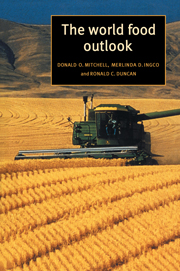Book contents
- Frontmatter
- Contents
- List of figures
- List of tables
- Preface
- List of abbreviations
- 1 The world food problem
- 2 The price of food
- 3 Gains in consumption levels
- 4 World food production increases
- 5 Population growth and food demand
- 6 The quantity and quality of the resource base
- 7 Raising yields
- 8 Changing consumption patterns
- 9 Simulating the future world food situation
- 10 The world can feed twice as many in twenty years
- 11 A robust prediction?
- 12 Africa presents a special challenge at the turn of the century
- Appendix The World Grains Model
- References
- Index
Appendix - The World Grains Model
Published online by Cambridge University Press: 06 November 2009
- Frontmatter
- Contents
- List of figures
- List of tables
- Preface
- List of abbreviations
- 1 The world food problem
- 2 The price of food
- 3 Gains in consumption levels
- 4 World food production increases
- 5 Population growth and food demand
- 6 The quantity and quality of the resource base
- 7 Raising yields
- 8 Changing consumption patterns
- 9 Simulating the future world food situation
- 10 The world can feed twice as many in twenty years
- 11 A robust prediction?
- 12 Africa presents a special challenge at the turn of the century
- Appendix The World Grains Model
- References
- Index
Summary
The World Grains Model used for the simulation analysis is a non-spatial, partial equilibrium, net-trade model. It was originally estimated in the early 1980s for use in forecasting and policy analysis and has been revised and updated several times, most recently in 1990. It is global in scope, with fifteen economies modelled individually and the remaining economies grouped into nine regions. The commodities included in the model are wheat, rice and coarse grains (maize, oats, barley, sorghum, rye, millet and mixed grains). Individual models are estimated for each commodity and economy or region with cross-linkages between commodities.
Production for each economy or region is determined as the product of separately estimated harvested area and yield equations. Harvested area is determined by a two-stage process where total area harvested is determined and then allocated among competing crops on the basis of lagged per acre revenues. Yields are estimated as a function of lagged crop prices, fertilizer prices, the proportion of area planted to high-yielding varieties and a linear trend.
Per capita imports of each commodity are estimated directly for importing economies as a function of population, income, domestic supply and prices. Ending stocks are estimated as a share of consumption and prices. Total consumption is obtained as an identity. Net exports are estimated for exporting economies as a function of the level of each commodity available for export and world prices. Consumption in the exporting economies is estimated as a function of population, income and prices. The model is solved simultaneously for the level of world prices which equates net imports and net exports.
- Type
- Chapter
- Information
- The World Food Outlook , pp. 183 - 199Publisher: Cambridge University PressPrint publication year: 1997



